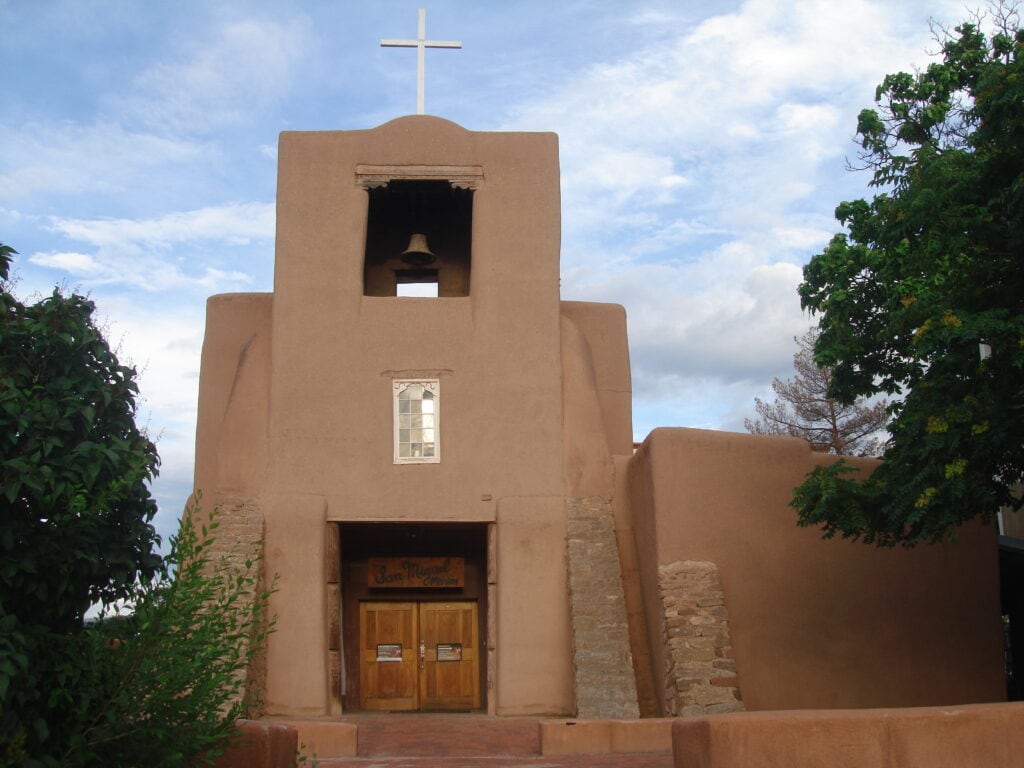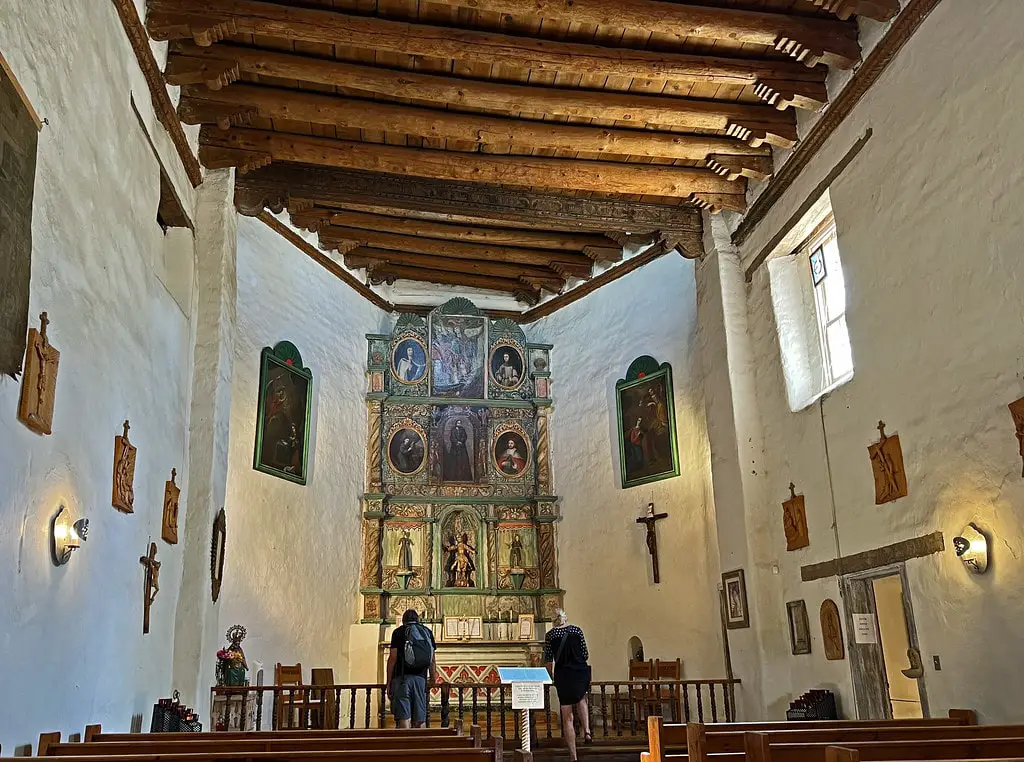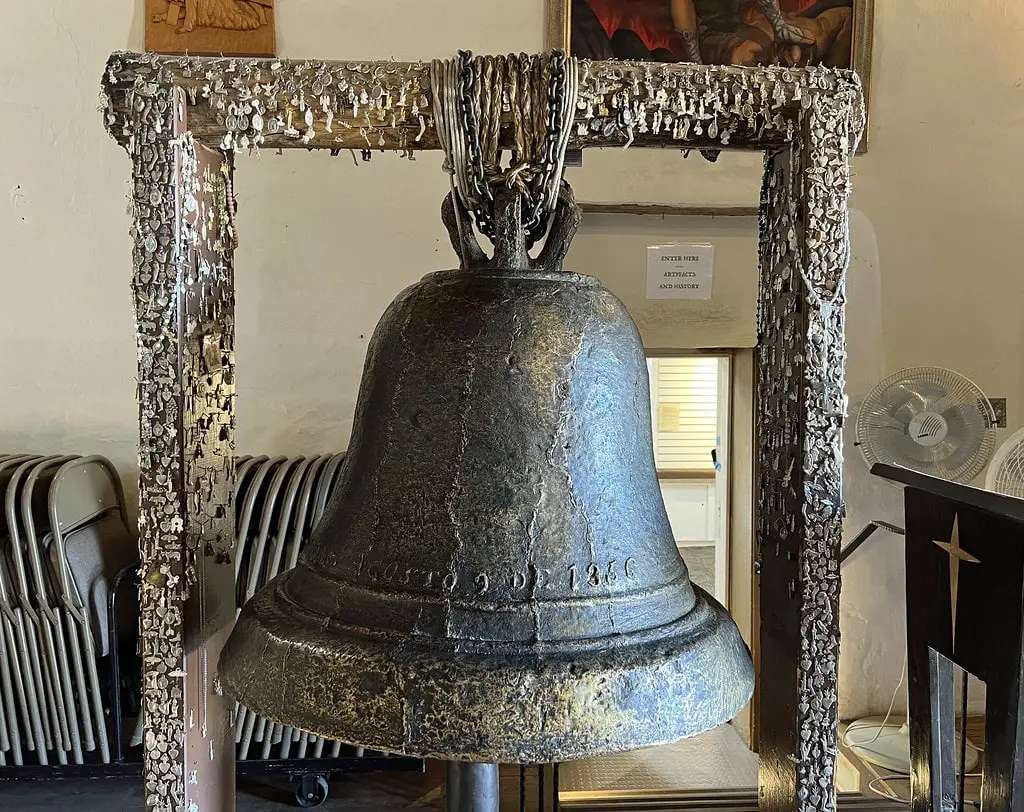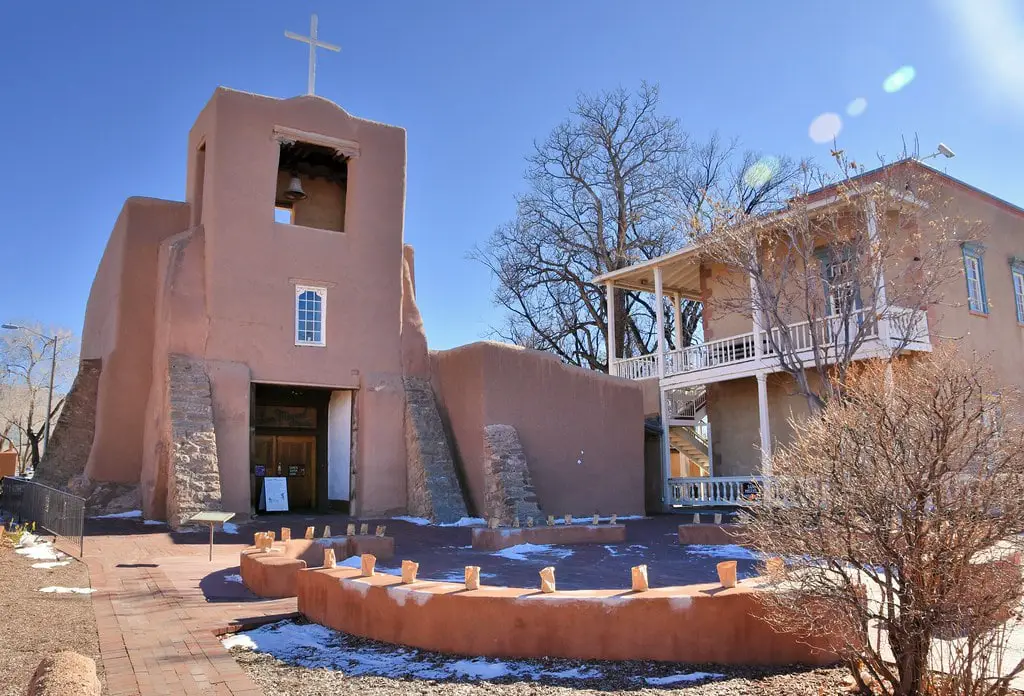The Historical Tapestry of San Miguel Chapel
In Santa Fe, New Mexico, San Miguel Chapel is a testament to American history’s rich tapestry. Known as the oldest church in the continental United States, its foundations trace back to the early 17th century, around 1610, mere years after Santa Fe was established.
This architectural gem, originally constructed under the guidance of Franciscan friars, was a spiritual haven and a focal point for the community, serving soldiers, laborers, and indigenous people from the Barrio de Analco.
The chapel’s narrative is one of resilience and rebirth. Throughout its storied past, it has witnessed the tumultuous events that have shaped the region. The Pueblo Revolt of 1680 marked a significant chapter in its history, leading to partial destruction and subsequent restoration.
The present structure, dating from 1710, bears the marks of these turbulent times yet stands as a symbol of enduring faith and community spirit.
San Miguel Chapel’s significance extends beyond its religious function. It is a cultural landmark, encapsulating its time’s architectural and artistic traditions. The meticulously constructed adobe walls and distinctive Spanish colonial design speak volumes about the craftsmanship and aesthetic sensibilities of the era.
The chapel’s interior, with its wooden reredos and the legendary San Miguel bell, adds layers of artistic richness, each element narrating its tale of heritage and devotion.
In the realm of preservation, San Miguel Chapel has been a focal point for concerted efforts to maintain its structural integrity and historical significance.
Organizations like Cornerstones Community Partnerships have played a pivotal role in ensuring the chapel’s adobe architecture is preserved and celebrated as a living piece of history. These efforts underscore the community’s commitment to safeguarding this treasure for future generations.
For those seeking to immerse themselves in the cultural and historical fabric of Santa Fe, San Miguel Chapel is more than just a destination; it’s a journey through time. Its walls echo past stories, inviting visitors to explore and appreciate the rich tapestry of American history.
For travelers and history enthusiasts, things to do in Santa Fe, New Mexico, include delving into the chapel’s past, a narrative woven from the threads of faith, resilience, and community spirit.
Architectural Marvel: The Adobe Fortress
San Miguel Chapel, a paragon of Spanish colonial architecture, stands as a fortress of faith in the heart of Santa Fe. Constructed primarily from adobe, the chapel’s walls, approximately 5 feet thick, are a testament to the architectural ingenuity of the early 17th century.
The structure’s design, deeply rooted in the Romanesque fortress church style, showcases heavily buttressed walls. This feature adds to its majestic appearance and fortifies its stance against the test of time.
The interior of the chapel is a harmonious blend of simplicity and grandeur. The single and rectangular nave stretches about 70 feet in length and 24 feet in width, culminating in a trapezoidal apse that adds a touch of geometric intrigue.
The ceiling, a structural marvel, is supported by wooden vigas, some square and dating back to the 1710 reconstruction, while others are round and serve as newer replacements.
These vigas are not just functional; they are a nod to the chapel’s historical narrative, each bearing the weight of centuries of devotion and perseverance.
The chapel’s facade, facing west, embodies austere elegance. The central bell tower, modest in height, is complemented by a single small window and a larger open void above the main entrance.
This design is both aesthetic and strategic. Five stone buttresses added in 1887 ensure the building’s stability and endurance. Integrating these elements, from the thick adobe walls to the strategic buttresses, underscores San Miguel Chapel’s status as an architectural marvel, a fortress of faith standing resilient through the sands of time.

Artistic Heritage: The Reredos and Bell of San Miguel
San Miguel Chapel’s artistic heritage is as rich and profound as its history. The chapel houses a wooden reredos or altar screen, a masterpiece dating back to 1798.
This exquisite art, attributed to the mysterious yet talented Laguna Santero, is a testament to the artistic prowess that flourished in the region during the late 18th century.
The reredos, with its intricate carvings and vibrant paintings, is not just an altar screen; it’s a canvas that narrates tales of faith and devotion.
The centerpiece of this artistic marvel is a wooden statue of St. Michael the Archangel, a figure of reverence and protection. Originating from Mexico in 1709, this statue has been a silent guardian of the chapel, its presence a constant throughout time.
The reredos is further adorned with paintings that are believed to be the work of the disciples of Bartolomé Esteban Murillo, adding layers of artistic and spiritual depth to the chapel’s ambiance.
Another significant artifact within the chapel’s walls is the San Miguel bell. This bell, mostly made of copper and weighing 780 pounds, is an object of intrigue and historical speculation.
Inscribed with the date “August 9, 1356,” the bell’s origin was shrouded in mystery, leading to debates and discussions among historians and enthusiasts alike.
However, historical research has revealed that the bell’s true date is 1856, which adds a layer of historical authenticity to its already rich narrative.
The artistic heritage of San Miguel Chapel, from the reredos to the bell, is a mosaic of history, faith, and artistry. Each element, each artifact within its walls, is a piece of the puzzle that makes up the chapel’s vibrant narrative, which continues to captivate and inspire to this day.

San Miguel Chapel in the 21st Century: Preservation and Adaptation
In the 21st century, San Miguel Chapel is a beacon of historic preservation and cultural significance.
The chapel’s enduring legacy is largely attributed to the meticulous preservation efforts spearheaded by organizations deeply rooted in the community’s heritage.
A pivotal moment in the chapel’s recent history was the collaboration with Cornerstones Community Partnerships, initiated in 2008.
This partnership began a major preservation effort to restore the chapel’s structural integrity while honoring its historical essence.
The preservation project, which began in 2010, was a monumental task. The initial phase involved removing the Portland cement stucco, which was not originally used in the chapel’s construction.
This was followed by extensive adobe repairs and the application of an adobe plaster finish coat, reinstating the chapel’s traditional appearance.
The project was not just a restoration of walls and roofs but a revival of the chapel’s soul, ensuring that its adobe architecture, a testament to the region’s cultural heritage, was preserved for future generations.
The preservation efforts were a community endeavor, with volunteer labor and financial contributions from residents and admirers of the chapel across the nation.
St. Michael’s High School, the proud owner and caretaker of the chapel since 1859, played a crucial role in ensuring that the chapel’s legacy was preserved while adapting to the changing times.
The community’s collective efforts, Cornerstones Community Partnerships, and the school underscore the chapel’s significance as a living monument. This structure embodies the past and embraces the present and future.
A Living Tradition: Religious and Cultural Significance
San Miguel Chapel’s significance transcends its architectural and historical attributes, serving as a vibrant center for religious and cultural activities.
As the oldest Catholic structure on its original foundation in the United States, the chapel continues to be a place of worship, with Mass celebrated at 3 p.m. on the first Sunday of each month.
This enduring tradition is a testament to the chapel’s role as a spiritual haven, offering solace and a sense of continuity amidst the ever-changing landscape of modern life.
The chapel’s cultural impact is equally profound. It stands at the crossroads of the Santa Fe Trail, El Camino Real, and Old Spanish Trail, making it a focal point for cultural exchange and community gatherings.
The chapel has witnessed and hosted many events, from concerts performed within its sacred walls to the observance of traditional ceremonies like Las Posadas during the Christmas season.
These events are not just social gatherings; they celebrate the rich tapestry of cultures and traditions that converge in Santa Fe.
Moreover, San Miguel Chapel is an educational and spiritual resource for St. Michael’s High School students, facilitating orientations and retreats that connect the younger generation with their heritage.
The chapel is also open to the public, allowing visitors to explore its history, architecture, and artistry.
Docents, well-versed in the chapel’s storied past, are present to narrate its history and answer questions, ensuring that the legacy of San Miguel Chapel is shared, appreciated, and preserved for years to come.

Embracing Modernity: San Miguel Goes Solar
In boldly striving towards modernity, San Miguel Chapel embraced an eco-friendly future by integrating solar technology into its ancient structure.
This significant leap, marked by installing 20 solar panels on the chapel’s roof in 2023, represents a harmonious blend of historical preservation and contemporary innovation.
The initiative, spearheaded by Cornerstones, a company renowned for its dedication to restoring historic structures, was driven by a commitment to reduce power costs and adhere to environmental sustainability, aligning with Pope Francis’ call to protect the environment.
The decision to go solar underwent meticulous planning and consideration, especially given the chapel’s location in the historic district of Santa Fe.
Cornerstones’ feasibility study addressed critical questions about the roof’s structural integrity and the panels’ visual impact.
The study concluded that the chapel’s flat roof was robust enough to support the panels, and the parapet provided adequate concealment, ensuring the panels remained discreet and the chapel’s historic facade unaltered.
The green light from St. Michael’s High School’s board of trustees set the project in motion, marking a significant milestone in the chapel’s history.
Though invisible to the onlooker, the solar panels symbolize a forward-thinking approach to preservation, ensuring that San Miguel Chapel remains a beacon of sustainability and resilience.
This integration of renewable energy into the fabric of the oldest church in the continental United States is a testament to the chapel’s ongoing relevance and its community’s commitment to stewardship of heritage and the environment.

The Oral Tradition and Documentary Evidence: Unraveling the Chapel’s True Age
The true age of San Miguel Chapel has long been a subject of intrigue and scholarly debate, with oral traditions and documentary evidence offering varying narratives.
The chapel’s first documented mention dates back to 1628, yet local lore and oral histories suggest its origins could be as early as 1610, coinciding with, or even predating, the official founding of Santa Fe.
This discrepancy between written records and oral accounts adds a layer of mystery to the chapel’s history, making it a focal point for historians and enthusiasts alike.
The importance of oral tradition in understanding the chapel’s past cannot be overstated. These narratives passed down through generations, are not merely stories; they are threads that weave the social and cultural fabric of the community.
They offer insights into the chapel’s significance in the lives of the people who built it, maintained it, and worshipped within its walls.
However, the absence of official documentation from the early years, particularly due to the destruction of records during the revolt of 1680, poses challenges to historians seeking to pinpoint the chapel’s exact date of construction.
Despite these challenges, the quest for knowledge continues. Documents referencing San Miguel Chapel have been unearthed in archives worldwide, from Mexico to Spain and even as far as London.
Each discovery adds a piece to the puzzle, offering glimpses into the chapel’s storied past and its role in the broader tapestry of American history.
As scholars and historians continue to sift through evidence and analyze oral histories, the narrative of San Miguel Chapel evolves, reflecting the dynamic interplay between tradition, documentation, and historical inquiry.
